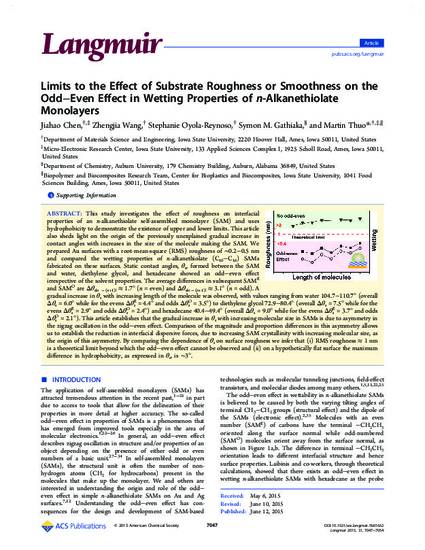
This study investigates the effect of roughness on interfacial properties of an n-alkanethiolate self-assembled monolayer (SAM) and uses hydrophobicity to demonstrate the existence of upper and lower limits. This article also sheds light on the origin of the previously unexplained gradual increase in contact angles with increases in the size of the molecule making the SAM. We prepared Au surfaces with a root-mean-square (RMS) roughness of ∼0.2–0.5 nm and compared the wetting properties of n-alkanethiolate (C10–C16) SAMs fabricated on these surfaces. Static contact angles, θs, formed between the SAM and water, diethylene glycol, and hexadecane showed an odd–even effect irrespective of the solvent properties. The average differences in subsequent SAME and SAMO are Δθs|n – (n+1)| ≈ 1.7° (n = even) and Δθs|n – (n+1)| ≈ 3.1° (n = odd). A gradual increase in θs with increasing length of the molecule was observed, with values ranging from water 104.7–110.7° (overall Δθs = 6.0° while for the evens ΔθsE = 4.4° and odds ΔθsO = 3.5°) to diethylene glycol 72.9–80.4° (overall Δθs = 7.5° while for the evens ΔθsE = 2.9° and odds ΔθsO= 2.4°) and hexadecane 40.4–49.4° (overall Δθs = 9.0° while for the evens ΔθsE = 3.7° and odds ΔθsO = 2.1°). This article establishes that the gradual increase in θs with increasing molecular size in SAMs is due to asymmetry in the zigzag oscillation in the odd–even effect. Comparison of the magnitude and proportion differences in this asymmetry allows us to establish the reduction in interfacial dispersive forces, due to increasing SAM crystallinity with increasing molecular size, as the origin of this asymmetry. By comparing the dependence of θs on surface roughness we infer that (i) RMS roughness ≈ 1 nm is a theoretical limit beyond which the odd–even effect cannot be observed and (ii) on a hypothetically flat surface the maximum difference in hydrophobicity, as expressed in θs, is ∼3°.
Available at: http://works.bepress.com/martin_thuo/29/

Reprinted with permission from Chen, Jiahao, Zhengjia Wang, Stephanie Oyola-Reynoso, Symon M. Gathiaka, and Martin Thuo. "Limits to the effect of substrate roughness or smoothness on the odd–even effect in wetting properties of n-alkanethiolate monolayers." Langmuir 31, no. 25 (2015): 7047-7054,doi:10.1021/acs.langmuir.5b01662. Posted with permission.